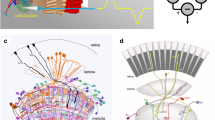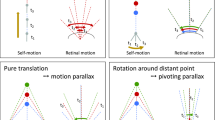Abstract
The study of the orientation behavior of flies requires the consideration of a few simple control systems for fixation and tracking. In this paper two such control systems are analyzed, in terms of the corresponding difference and differential equations. The first control system corrects with a delay ɛ the angular trajectory proportionally to the error angle ψ; the second control system also corrects proportionally to the error angle ψ but only when the absolute value of ψ is increasing. The differential equations are
and
u[ ] being the step function (u[x]=1 if x>0, otherwise u[x]=0). Under suitable restrictions on the parameters it is proved (a) that the difference equations
and
which can be associated to Eqs. (0) and (*), are “asymptotically equivalent” (for large n) if the time scale is “smoothed” over two time units and (b) that the second equation, with 0<α<2, always converge to a set of oscillating solutions of period 2 for arbitrary initial conditions. Numerical simulations show that the delay-differential equations behave in a similar way. We have also demonstrated with computer simulations that both control systems can satisfactorily predict the 3-D trajectory of a fly chasing another fly. The main biological implications of the analysis are: (1) The two control systems are practically equivalent descriptions of the fly's control of flight on a “coarse” time scale (2 times the fly's delay), consistently with an earlier more general derivation of Eq. (0) (Poggio and Reichardt, 1973). (2) On a fine time scale the second control system is characterized by an asymptotic oscillation with period twice the fly's delay. It is conjectured that a wide range of control systems of the same general type must have a similar oscillatory behavior. Finally, we predict the existence of asymptotic oscillations in the angular trajectory and the torque of tracking flies (if a control system of the second type is involved to a significant extent). Such oscillations should have a basic period of twice the effective reaction delay, and should be best detectable outside the binocular region. Closed loop experiments and the analysis of free flight trajectories may provide critical tests of this prediction.
Similar content being viewed by others
References
Bülthoff, H., Poggio, T., Wehrhahn, C.: 3-D analysis of the flight trajectories of flies (Drosophila melanogaster). Z. Naturforsch. 35c, 811–815 (1980)
Geiger, G.: Optomotor responses of the fly Musca Domestica to transient stimuli of edges and stripes. Biol. Cybern. 16, 37–43 (1974)
Geiger, G.: Is there a motion-independent position computation of an object in the visual system of the housefly? Biol. Cybern. (in press 1980)
Geiger, G., Poggio, T.: The orientation of flies towards visual patterns: On the search for the underlying functional interactions. Biol. Cybern. 19, 39–54 (1975)
Götz, K.G.: The optomotor equilibrium of the drosophila navigation system. J. Comp. Physiol. 99, 187–210 (1975)
Götz, K.G., Wenking, H.: Visual control of locomotion in the walking fruitfly Drosophila m. J. Comp. Physiol. 85, 235–266 (1973)
Götz, K.G., Hengstenberg, B., Biesinger, R.: Optomotor control of the wing beat and body posture in Drosophila. Biol. Cybern. 35, 101–112 (1979)
Hadeler, K.P., Mottoni, P. de, Schumacher, K.P.: Dynamic models for animal orientation. J. Math. Biol. 10, 307–332 (1980)
Hale, J.: Theory of functional differential equations. New York, Heidelberg, Berlin: Springer 1977
Heiden, U. an der. Delays in physiological systems. J. Math. Biol. 8, 345–364 (1979)
Heisenberg, M., Wolf, R.: On the fine structure of yaw torque in visual flight orientation of Drosophila melanogaster. J. Comp. Physiol. 130, 113–130 (1979)
Land, M.F., Collett, T.S.: Chasing behaviour of houseflies (Fannia canicularis). J. Comp. Physiol. 89, 331–357 (1974)
Pick, B.: Visual flicker induces orientation behaviour in the fly musca. Z. Naturforsch. 29c, 310–312 (1974)
Pick, B.: Visual pattern discrimination as an element of the fly's orientation behaviour. Biol. Cybern. 23, 171–180 (1976)
Poggio, T., Reichardt, W.: A theory of the pattern induced flight orientation in the fly Musca domestica. Kybernetik 12, 185–203 (1973)
Poggio, T., Reichardt, W.: Visual control of orientation behaviour in the fly. II. Towards the underlying neural interactions. Q. Rev. Biophys. 9, 348–375 (1976)
Reichardt, W.: Musterinduzierte Flugorientierung. Naturwissenschaften 60, 122–138 (1973)
Reichardt, W., Poggio, T.: A theory of the pattern induced flight orientation of the fly Musca Domestica II. Biol. Cybern. 18, 69–80 (1975)
Reichardt, W., Poggio, T.: Visual control of orientation behaviour in the fly. I. A quantitative analysis. Q. Rev. Biophys. 9, 311–346 (1976)
Reichardt, W., Poggio, T.: Visual control of flight in flies. In: Recent theoretical developments in neurobiology. Reichardt, W., Poggio, T. (eds.). Cambridge, MA: MIT Press 1980
Wagner, H.: Diplomarbeit, Universität Tübingen, 1980
Wehrhahn, C.: Flight torque and lift responses of the housefly (Musca domestical) to a single stripe moving in different parts of the visual field. Biol. Cybern. 29, 237–247 (1978)
Wehrhahn, C., Hausen, K.: How is tracking and fixation accomplished in the nervous system of the fly? Biol. Cybern. 38, 179–186 (1980)
Wehrhahn, C., Reichardt, W.: Visually induced height orientation of the fly Musca domestica. Biol. Cybern 20, 37–50 (1975)
Author information
Authors and Affiliations
Rights and permissions
About this article
Cite this article
Poggio, T., Reichardt, W. Visual fixation and tracking by flies: Mathematical properties of simple control systems. Biol. Cybern. 40, 101–112 (1981). https://doi.org/10.1007/BF00344289
Received:
Issue Date:
DOI: https://doi.org/10.1007/BF00344289




